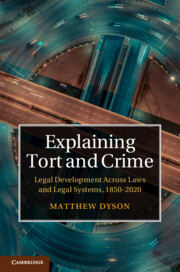Book contents
- Explaining Tort and Crime
- Explaining Tort and Crime
- Copyright page
- Contents
- Foreword
- Preface
- Table of Cases
- Table of Legislation
- Part I Setting the Scene: Introduction and Methods for Explaining
- Part II Mental States and Careless Acts: The Development of Fault Doctrine in Crime and Tort
- Part III Procedures Interfacing Tort and Crime
- Part IV Conclusions
- 9 Tracing Patterns of Development
- 10 Conclusion
- Index
10 - Conclusion
from Part IV - Conclusions
Published online by Cambridge University Press: 07 July 2022
- Explaining Tort and Crime
- Explaining Tort and Crime
- Copyright page
- Contents
- Foreword
- Preface
- Table of Cases
- Table of Legislation
- Part I Setting the Scene: Introduction and Methods for Explaining
- Part II Mental States and Careless Acts: The Development of Fault Doctrine in Crime and Tort
- Part III Procedures Interfacing Tort and Crime
- Part IV Conclusions
- 9 Tracing Patterns of Development
- 10 Conclusion
- Index
Summary
This work has sought to explore four key places of overlap and potential interaction between crime and tort to better understand both the field as a whole and how and why legal systems change. It has tried to avoid normative claims bound to specific times, and particular theories about the relationship between tort and crime. It has shown that tort and crime in England and elsewhere address many of the same fact patterns, using concepts given the same names and with the same or similar function, and that both pursue some of the same purposes. It has presented a picture of complex and varied ways in which interactions and non-interactions have happened. Across that material, issues, processes and outputs have led to significant legal change over the period 1850–2020.
- Type
- Chapter
- Information
- Explaining Tort and CrimeLegal Development Across Laws and Legal Systems, 1850–2020, pp. 477 - 482Publisher: Cambridge University PressPrint publication year: 2022



